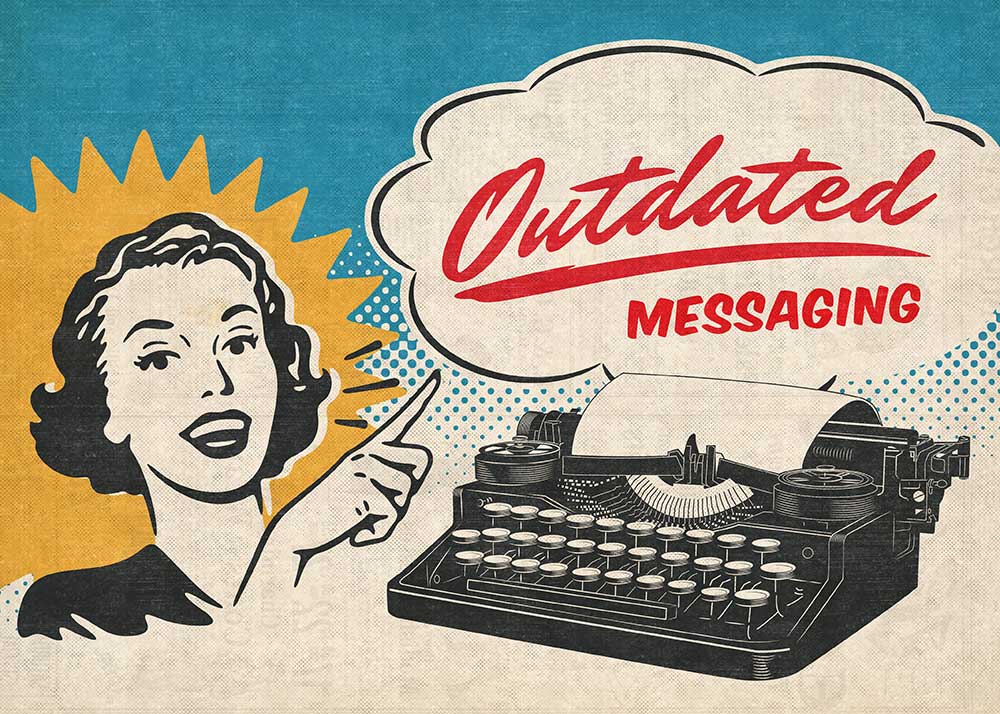Industry experts shared tips and strategies to help manufacturers convert more customers and navigate the current landscape.
Logos create the look and feel of a company from the outside. But beneath that image, there is the “who,” the “why,” and the “how” that are the heart and soul of a company. Messaging is the vehicle that drives differentiation in competitive industries. Yet many manufacturers continue to overlook their messaging and rely on outdated, ineffective materials to win customers.

Currently, many manufacturers find themselves in the midst of reinvention. Whether it be due to current events, the ongoing impact of Industry 4.0 or just natural changes over time, companies are evolving at a rapid pace. Now is the time for manufacturers to reevaluate their messaging and decide whether it is propelling them forward or holding them back.
The topic of outdated messaging was on the menu for a recent Lunch & Learn hosted by Industry Today’s Susan Poeton on June 18th. During the presentation, keynote speaker Paul Kiesche of Aviate Creative addressed the current state of manufacturing, noting that, “Manufacturing companies have evolved. Whether your company is five or one hundred years old, there’s a good chance it has had to pivot or adapt…Does your messaging reflect your current brand, or is it misrepresenting your brand and costing you customers or more?”
Rather than updating and enhancing their message, many manufacturers rely on their company history as a crutch. Ultimately, this limits the company’s potential to acquire new customers, increase sales, move ahead of the competition, attract employees and reawaken existing customer relationships.
No matter how well it is written, outdated messaging will always fall on deaf ears. In order to be heard and remembered, manufacturers must leverage their brand voice.
This can be achieved through an introspective discovery process. Decision makers need to sit down and establish the company’s current differentiators, customer personas, SWOT (strengths, weaknesses, opportunities and threats), competition and other criteria. This will allow the company to find its unique voice that will be communicated through the logo, messaging and all other branding.
Brand voice also helps manufacturers craft their stories and add color to otherwise commodity services and products. During the recent Lunch & Learn, keynote speaker Jessica Clark of The Content Creamery delved further into the role that brand voice plays in converting and engaging customers. Clark encouraged manufacturers to remember that, “Everyone loves a good story, so take the time to craft yours and share it. Stories pull people in—there’s a reason why humans have been telling them since the beginning of time. Your story will show the more human side of your company and it’s going to earn trust and always keep your customers more engaged.”
In the past, it was enough for companies to promote a high-quality, American-made product to stand out from the pack. Today, manufacturers find themselves in a much more competitive market that warrants thinking far beyond the product.
During the event, guest panelist Todd Hockenberry from Top Line Results shared his belief that the new edge in manufacturing lies in the customer experience:
The vast majority of manufacturing companies today still market the product…They don’t say what the outcome of working with you is. I would argue that the customer experience that you deliver from first touch through that long relationship…That experience is the key differentiator for most manufacturing companies. And most of them don’t even recognize that.
Companies need to explore their messaging from a new angle that highlights the experience rather than the product. Manufacturers likely already have processes in place that ensure a seamless experience for the customer. But companies need to shift their messaging and make these benefits more apparent to customers from the start.
Co-guest panelist David Caron from Industrial Sage stated that manufacturers should always consider their “why” when it comes to any form of customer engagement:
Why should people care what you have to say? If you don’t understand why people should care about it, then it’s always going to fall flat…You need your messaging to be relevant for the widest audience within your target audience and try to get 70 to 80 percent of the people visiting your website to engage further.
Change has overtaken the manufacturing industry by storm. As the global market slowly begins to recover, now is the time for manufacturers to reflect on their message in order to move forward. Companies that position themselves as the solution to customers’ current problems will undoubtedly surpass those that rely on old messaging to meet new demands.

Jessica Clark
Jessica Clark is the owner of The Content Creamery, a marketing agency specializing in content strategy and copywriting services. Providing creative and results-driven solutions across several industries, Jessica has a particular focus in the food and beverage industry with a professional background in food service. Her mission is to help clients establish and leverage their own unique message to achieve their business goals and stand out from the crowd.
Contact
thecontentcreamery.com
732-997-7248
info@thecontentcreamery.com
In this episode, I sat down with Beejan Giga, Director | Partner and Caleb Emerson, Senior Results Manager at Carpedia International. We discussed the insights behind their recent Industry Today article, “Thinking Three Moves Ahead” and together we explored how manufacturers can plan more strategically, align with their suppliers, and build the operational discipline needed to support intentional, sustainable growth. It was a conversation packed with practical perspectives on navigating a fast-changing industry landscape.